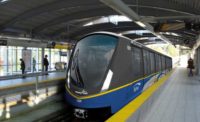Quantifiable Data Model Could Promote Use of Accelerated Bridge Methods
As accelerated bridge construction (ABC) catches on quickly in the United States—particularly in Utah—a former Federal Highway Administration engineer now at the Oregon Dept. of Transportation wants to create national standards for the practice.

Benjamin Tang, ODOT’s bridge preservation managing engineer, says readily available criteria adaptable nationwide can help bridge owners establish when ABC construction makes sense. “We are trying to create something that addresses some of the criteria used by the owners to make choices that will result in the best selection,” he says. “Putting quantifiable data, when available, into the model will give engineers more confidence about their analysis.”
Almost halfway through an 18-month study as part of a 12-state collaboration, Tang expects the final report will not only highlight already well-known benefits of ABC—mobility, accessibility and quality—but quantify the factors, giving owners and engineers tools to promote the approach. An FHWA spokesman declined to comment on the study’s implications, citing its ongoing nature.
Utah Dept. of Transportation has led the way in replacing bridges swiftly using the ABC method, particularly self-propelled modular transporters that slide out an old bridge and slide in a preconstructed new bridge, often over the course of a weekend. In one summer alone UDOT replaced 12 bridges using ABC).
Randy Park, project development director for the Utah Dept. of Transportation, a study participant, says his state gathers a “ton” of information about ABC’s impacts, both from a user- impact and user-cost standpoint, even taking into consideration political components and the projected decrease in highway accidents due to the swift bridge replacements.
Tang’s study aims to quantify the direct costs of construction, indirect costs of traffic gridlock, average daily traffic, construction safety, schedule needs, site constraints and customer service expectations. And those are just the high-level criteria. The low-level criteria include the costs of traffic control, lost toll revenue and more.
“Accelerated bridge construction could be used on a broader base,” Tang adds, noting that Oregon now has 15 bridges built through accelerated construction. “We are trying to come up with a decision-making piece to help engineers [who] accelerate a bridge. Now they can document and justify their decision.”
Tang’s goal puts the idea of ABC at the front of the decision-making process, making it as important as choosing between concrete and steel. The study aims to help engineers sell the idea for everything from bread-and-butter bridges to specialty projects.
“The process is a comparison of several criteria, not just a yes-or-no answer,” Tang says. His model uses subjective data and hard figures, but it also uses comparisons to show preferred solutions when owners don’t have hard numbers.
This quantifiable data will be powerful for engineers, says Scott Nettleton, civil engineer in the Salem, Ore., office of San Francisco-based T.Y. Lin International. “Here is some documentation that isn’t code,” Nettleton says. “It is always better to have a discussion like this earlier in the project as part of the standard design process.”






